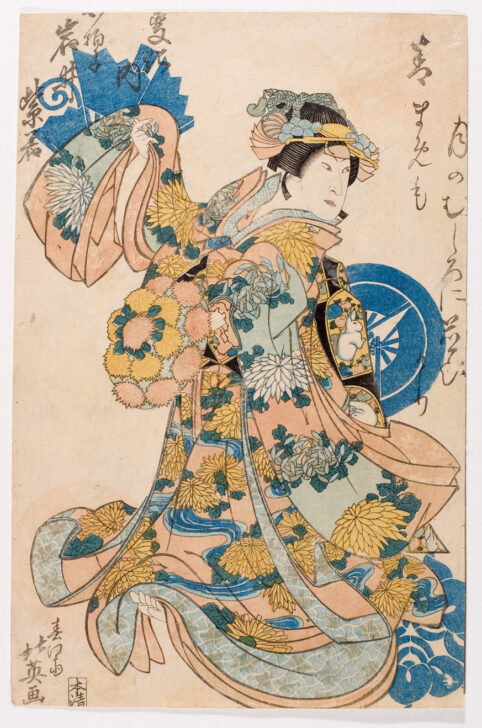Praying for Love in the Dew-Covered Fall Grasses: Iwai Shijaku I as a Shirabyōshi
Hokuei

Description
Subject Matter:
This image is part of a set of five, of which the museum has three. The prints depict each of the five roles Iwai Shijaku I performed in the play Praying for Love in the Dew-Covered Fall Grasses. In this print, he plays the part of a shirabyōshi dancer. Shirabyōshi were itinerant female entertainers, known for their dances to popular songs and rhythmic accompaniment. The practice developed from the late twelfth century where shirabyōshi were associated with religious performance. These generally lower class women were famous for dressing in men’s, specifically warriors’ clothing including a white top, sword, and tall hat (eboshi). This print has none of those iconic characteristics, however the role is made clear by the inscription at the top left which indicates this is one of five roles, specifically the shirabyōshi.
Iwai Shijaku I was also known as Iwai Hanshiro VII. He was born in 1804 and active from 1806 until his death in 1845. He spent time acting in Edo as well as Osaka, where this play was performed in 1832.
Physical Description:
In this image a woman dances, looking over her left shoulder. She is dressed in an elaborate robe with colorful floral patterns in green, orange, yellow, and white. Maple leaves line the blue border of her robe. Two white rabbits are visible on her black sash. She wears an elaborate head dress in gold, blue, and orange. In the background are five crests, three blue and two red (very faded).
Inscriptions: Shunbaisai Hokuei ga (Artist's signature); Honsei (Publisher's seal); 「青まめも月のむしろに並ひけり 紫若」(Text); gohenka no uchi, shirabyōshi, Iwai Shijaku (Title)
Usage Rights:
If you are interested in using an image for a publication, please visit https://umma.umich.edu/request-image/ for more information and to fill out the online Image Rights and Reproductions Request Form.